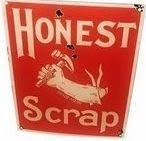SEVERAL springs ago some friends and I arose before dawn in Moab, Utah, to witness the sunrise mating dance of the Gunnison sage grouse: a surreal display of nine ornately plumed, chicken-size birds tottering about amid the sagebrush like windup toys, fanning their spiky tails and uttering a magical sound — “pop … pop-pop!” — as they thrust yellow air sacs out of their snow-white chests.
Read the rest of the article and support adding the Gunnison sage grouse, the drumming lover, to the endangered species act.
On the matter of we people expanding into the wild, the veld, we decide whether to deep clean and cultivate assiduously the earth or whether to leave unturned and uncultivated the earth upon which we trod. In between this binary choice–turning or not turning the soil–there is no middle ground. This choice is one of those locked-down moments of either-or, either alive or dead, nothing in between, either turning the soil for cultivation or leave it alone.
Therefore, to keep alive and robust the biota of this good earth–the Gunnison sage grouse, for example, –we must as a people, as temporary tenants of this space, here and now, leave sufficient areas of territory for species to live, to roam, to rest, to raise families. Yes, we need to cultivate land as well, but large tracts of it? At the expense of destroying major habitats? In response to all living things, therefore, let us ratchet down, pin down less tightly, our clearing land and cutting trees and brush, so that we as a people can rise early in the morning and attend the dance of life in those spaces we have tenderly set aside.
(To be continued, The post-industrial order.)

















I couldn’t agree more Jack. I treasure those “spaces we have tenderly set aside” and support their protection for future generations of all species.
Yes, setting aside those parts for future generations is so important. I think of my grand children and what I want them to enjoy.
Good Morning, Jack! I have chosen to mow a little less of what was once a rather large yard here, but it’s still extensive and I love the part like look to it, but I also have many areas of natural habitat which I am so very glad for and love the wild life that make it home. Nothing matters more on this planet than to preserve numerous and large areas for those whose homes require it. Our own should require it, as well. Far too many are very far removed from what’s natural and good.
Teresa, I have a field that I allow swatches of native grasses to grow. You have a beautiful place, your Lonewolf property.
Jack, your comment – “… leave sufficient areas of territory for species to live, to roam, to rest, to raise families. ” is an essential-much-needed testament. Either / or – I totally agree, too. Seeing all beings as equal, and important – now there’s a true spirit of democracy.
The author Susan J. Tweit in her book of essays entitled “Barren, Wild and Worthless” writes of the Prairie Dog’s contribution to the health of desert soils. Some bent on eradicating them with poison. This attitude is all around us – so, let’s clamor louder!
Oh, yes, clamor louder. I have read about the prairie dog and their contributions and family life. Such social creatures. Thank you, Cirrelda.
Jack, now you’re talking about a big deal where I live (southern Utah), and the sage grouse issue is making the anti-environmentalists crazy! First, of course I agree with you; if a species is endangered, then it needs to be listed and protected, period. Just south of Moab is San Juan County; just this week, my state rep (Mike Noel) put forward a bill that would allow those whose property was listed as habitat for endangered species to pay lower property taxes because that owner could not fully get from the property what it was worth, such as using it to grow something. This of course is a load of crap (as is Mike Noel), but that’s the kind of thing going on in our legislature. Utah’s legislature is even worse than Texas’, if only because it convenes annually instead of bi-annually!
Meanwhile, right here in Kane County where I live the sage grouse (a different type from the Gunnison) is also losing habitat and might well be listed as endangered. This is critically important because it lives on the very (BLM) land proposed for an expansion of a surface coal mine. Owners want to expand onto 3,500 additional acres–coming within ten short visible miles of the magnificent Bryce Canyon National Park–to mine coal which would be sent to California and China, doing great damage to small tourist cities and roads as, 24/7, it is transported to the train that would carry it out. So listing the sage grouse here would stop that expansion and save this beautiful country and clean air from a surface coal mine that no one really benefits from but the owners. For more info on this mine, please visit the Sierra Club website http://www.haltaltoncoal.com. There you can find out what you can do to help in the fight.
So around here the beautiful, interesting sage grouse (who nests on the ground) is a good friend. And believe me, the county commission here would have it otherwise. We are fighting hard against them.
Thank you, Caralee, for your extended comments! The coal mine within 10 miles of Bryce is just an abomination, it is! These rapacious idiots that control legislatures should be voted out now. I do hope that the sage grouse can be listed as endangered. It is a moment to consider that one species of bird, if protected by law, can prevent mining and damaging wastes to the environment. Our common good overlaps the existence of a bird, really, just a bird, but a symbol of things wild and free. Fight hard, the life of a grouse and we depend upon it. Say hello to Jimmy for me.
I’m amazed at the close parallels between this creature and our Attwater Prairie Chickens . The Nature Conservancy has a refuge for them just down the road from me. I’ve not yet been out to see their booming grounds in the mating season, but it’s on my list of things to do.
I have noticed this year that around my apartment complex there are more song birds as well as water birds. I’ve seen cardinals, blue jays, goldfinch. It’s a clear indication that people are either planting more cover or allowing what’s here to develop. Even in non-drought years we’ve never had so many birds. It’s a good sign.
Linda, I have begun to notice more birds singing in the morning. Here, with the ponds low, drought continues. That you have a conservancy nearby is exciting. I have not seen the prairie chicken drum either.
Sometimes it goes beyond leaving areas alone. In this area where fields have grown to forests our diversity has been lessened. Given we discourage forest fires, natures way of opening areas up, it sometimes is necessary to open up land and allow other plants to work their way in. I’m doing a small wildlife clearing now in the middle of a large forest. It be used heavily by deer, woodcock, field mice, voles, and their predators, and out drumming bird of the Northeast, the ruffed grouse.
Good stuff here Jack, food for thought!
Hi, Bill! I do love those open areas. I have many of them. The open space will give them better line of sight? And plants they can eat will flourish? I have a disc implement for my tractor that I use to open up the soil for water retention and aeration. In fact, I am doing that today. Good to hear from you.
Jack, I’d like to e-mail you a copy of “Rings of Trust.” It involves the KKK and other issues I’m tackling. If you’d like, please email me.
Sure, Kittie, please send it.